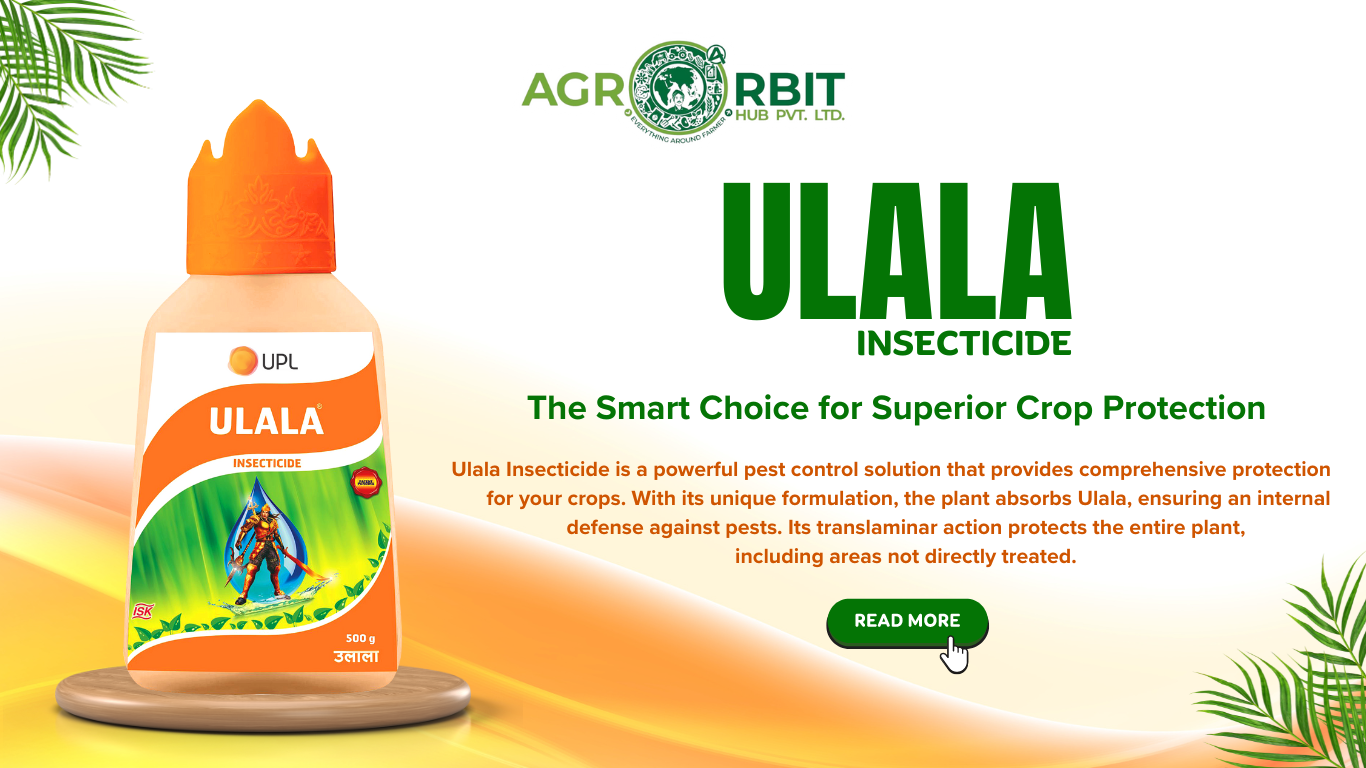

Ulala: The Future of Sustainable Pest Control in Agriculture
Precision, Protection, and Productivity with Ulala
Introduction
In the ever-evolving realm of
modern agriculture, effective pest control is paramount to ensuring healthy
crop yields and sustainable farming practices. One standout product in this
domain is Ulala, an innovative insecticide developed by UPL Limited. Ulala
represents a blend of cutting-edge science and environmental responsibility,
making it a favored choice among Indian farmers. With its active ingredient
flonicamid, Ulala targets specific pests with precision, safeguarding crops
while promoting ecological balance. This blog delves into the powerful
attributes of Ulala, exploring its mode of action, target pests, and the myriad
benefits it offers to the agricultural sector.
Unpacking Ulala: The
Power Within
Active Ingredient: Ulala's
efficacy stems from its active ingredient, flonicamid (50% WG).
Flonicamid is a systemic insecticide known for its unique mode of action,
targeting specific pests while remaining environmentally considerate.
Target Pests:
Ulala excels in managing a wide range of sucking pests, which are notorious for
damaging crops. The key pests it controls include:
Aphids
Aphids are small sap-sucking
insects that can cause significant damage to a wide variety of crops. They feed
on plant juices, leading to weakened plants, distorted growth, and reduced
yields. Additionally, aphids can transmit plant viruses, further compromising
crop health. Ulala's systemic action ensures that aphids are controlled
efficiently, preventing the spread of disease and maintaining plant vigor.
Whiteflies
Whiteflies are tiny, winged
insects that feed on the undersides of leaves. They excrete a sticky substance
known as honeydew, which promotes the growth of sooty mold on plants. This not
only reduces photosynthesis but also makes the plants unattractive and less
marketable. Ulala effectively disrupts the feeding of whiteflies, reducing
their population and minimizing the impact of honeydew and sooty Mold.
Jassids
Also known as leafhoppers,
jassids are small, agile insects that damage plants by sucking sap from leaves
and stems. This feeding results in a condition known as "hopper burn,"
characterized by yellowing, curling, and drying of leaves. By targeting
jassids, Ulala helps to prevent hopper burn and ensures that plants remain
healthy and productive.
Brown Plant Hoppers (BPH)
Brown plant hoppers are major
pests of rice crops. They feed on the plant's sap, causing wilting and hopper
burn. BPH can also transmit viral diseases, which further jeopardize crop
health. Ulala's action against BPH is critical for protecting rice yields and
ensuring food security in regions where rice is a staple crop.
Green Leafhoppers (GLH)
Green leafhoppers are another
significant pest of rice and other crops. Their feeding activity results in the
characteristic yellowing and drying of leaves, similar to other sucking pests.
By controlling green leafhoppers, Ulala helps maintain the health and
productivity of affected crops, ensuring better yields.
White-Backed Plant Hoppers
(WBPH)
White-backed plant hoppers are
yet another pest of rice, known for their sap-sucking behavior and ability to
transmit diseases. They cause similar damage to brown plant hoppers, including
wilting and hopper burn. Ulala's effectiveness against WBPH ensures that rice
plants remain healthy and free from the debilitating effects of these pests.
Crops and Versatility
Ulala's versatility is one of
its standout features. It is registered for use on various crops, including:
Cotton
Cotton is a crucial crop in
India, providing raw material for the textile industry and a livelihood for
millions of farmers. Cotton plants are highly susceptible to attacks from pests
like aphids and whiteflies, which can significantly reduce yield and quality.
Ulala's targeted action against these pests ensures that cotton plants remain
healthy, leading to higher productivity and better-quality fibers.
Vegetables
Vegetables are an essential
part of the human diet, providing vital nutrients. However, they are often
attacked by a variety of sucking pests, which can affect both the yield and
quality of the produce. Ulala's ability to control pests like aphids and whiteflies
helps in maintaining the health of vegetable crops, ensuring that the produce
is abundant and of high quality.
Fruits
Fruit crops are highly valued
for their economic and nutritional benefits. However, they are also vulnerable
to pest attacks, which can cause direct damage to the fruits and reduce their
marketability. Ulala protects delicate fruit crops from harmful insects,
ensuring that the fruits develop properly and reach the market in prime
condition.
Ornamentals
Ornamental plants are grown for their aesthetic value and are an integral part of gardens and landscapes. The health and appearance of these plants can be severely compromised by sucking pests. By using Ulala, growers can maintain the aesthetic and health of ornamental plants, ensuring that they continue to enhance the beauty of their surroundings.

Mode of Action: Disruption for Control
The effectiveness of Ulala
lies in its innovative mode of action, which sets it apart from many
conventional insecticides. Unlike insecticides that kill pests on contact,
Ulala utilizes a unique mechanism that targets the pests' feeding behaviour.
This systemic action is both precise and effective, ensuring thorough pest
control while minimizing environmental impact.
Systemic Action
Ulala is a systemic
insecticide, meaning that it is absorbed by the plant and distributed
throughout its tissues. When pests feed on the plant, they ingest the active
ingredient, flonicamid. This ensures that even pests hidden in hard-to-reach
areas or those that migrate within the plant are effectively controlled.
1. Absorption and
Distribution: After application, Ulala is taken up by the
plant's roots or leaves. It then moves through the plant's vascular system,
reaching all parts of the plant. This internal distribution ensures that the
entire plant is protected, not just the areas where the insecticide was
applied.
2. Ingestion by Pests: When sucking pests, such as aphids, whiteflies, and jassids, feed on the treated plant, they ingest the flonicamid present in the plant's tissues. This makes Ulala highly effective against pests that are difficult to reach with contact insecticides.
Disruption of Feeding Behaviour
Flonicamid targets the nervous
system of sucking pests. Upon ingestion, it interferes with the pests' feeding
process. Specifically, flonicamid blocks the transmission of signals within the
nervous system that are necessary for feeding. As a result, pests quickly cease
feeding, typically within a few hours of exposure. This rapid cessation of
feeding prevents the pests from causing further damage to the plant.
1. Interference with Neural
Signals: Flonicamid acts on the nicotinic acetylcholine receptors
in the nervous system of the pests. By binding to these receptors, it disrupts
the normal transmission of neural signals that control feeding behaviour. This
action effectively "turns off" the pests' ability to feed.
2. Immediate Cessation of
Feeding: Once the neural signals are disrupted, the pests stop
feeding almost immediately. This rapid response is crucial in preventing
further damage to the plant, as the pests are no longer able to suck sap and
nutrients from the plant tissues.
Long-Lasting Control
The disruption of feeding
behaviour leads to the eventual death of the pests due to starvation. This mode
of action provides long-lasting control because:
1. Extended Efficacy: The
pests stop feeding almost immediately after exposure, reducing the damage they
can cause. Over time, the lack of nutrition leads to their death. This
prolonged effect means that the insecticide continues to work long after the
initial application.
2. Reduced Reproduction: By
stopping feeding early in the life cycle, Ulala also helps in reducing the
reproduction rates of pests. Sucking pests often reproduce rapidly, so
disrupting their ability to feed can significantly lower their population
growth. This population control is essential for maintaining low pest levels
over the growing season.
3. Minimized Re-Infestation: The
systemic nature of Ulala ensures that new pests that start feeding on treated
plants will also be affected, providing ongoing protection and reducing the
likelihood of re-infestation. This continuous protection helps in managing pest
populations throughout the crop cycle.
Reduced Need for Frequent Applications
Because Ulala provides
long-lasting control, the need for frequent reapplications is minimized. This
offers several benefits:
1. Cost-Effective:
Farmers save on the cost of insecticide and labour involved in multiple
applications. This cost savings is significant, especially for large-scale
farming operations where labour and chemical costs can be substantial.
2. Environmental Safety: Fewer
applications mean less chemical input into the environment, aligning with
sustainable agricultural practices. Reducing the amount of insecticide used
helps in minimizing the impact on non-target organisms and the surrounding
ecosystem.
3. Labor Efficiency:
Farmers can focus on other essential tasks rather than repeatedly applying
insecticides. This efficiency allows farmers to allocate their time and
resources to other critical aspects of crop management, such as irrigation,
fertilization, and harvesting.
Safety for Beneficial Insects
One of the significant
advantages of Ulala's mode of action is its selectivity. While it is highly
effective against target pests, it has a minimal impact on beneficial insects.
Pollinators, such as bees, and natural pest predators, like ladybugs, are less
likely to be harmed because they do not feed on the treated plant tissues in
the same way that sucking pests do. This preservation of beneficial insect
populations is crucial for maintaining the ecological balance and promoting
healthy crop growth.
1. Protection of Pollinators: Pollinators
play a vital role in the production of many crops by facilitating pollination.
Ulala's selective action ensures that these beneficial insects are not
adversely affected, promoting better fruit and seed set.
2. Conservation of Natural Enemies: Natural predators and parasitoids help in controlling pest populations naturally. By preserving these beneficial insects, Ulala supports integrated pest management (IPM) strategies that rely on biological control methods.


General Guidelines for
Spraying Ulala
- Early Morning or Late Afternoon:
- Temperature:
Spraying in the early morning or late afternoon helps avoid the hottest
part of the day. Extreme temperatures can reduce the effectiveness of the
insecticide.
- Wind: These times are
usually calmer with less wind, reducing the risk of drift and ensuring
better coverage of the plants.
- Early Infestation Stage:
- Pest Monitoring:
Regularly monitor your crops for the presence of pests. Spraying at the
early stages of infestation helps to control the pest population before
it becomes severe.
- Threshold Levels:
Apply Ulala when pest populations reach the economic threshold level,
meaning the point at which the cost of pest damage exceeds the cost of
control.
- Avoid Rain:
- Weather Conditions:
Ensure there is no forecast of rain within 24 hours of application. Rain
can wash away the insecticide, reducing its efficacy.
- Coverage:
- Uniform Application:
Ensure thorough and uniform coverage of the plant foliage. This ensures
that the systemic action of Ulala can protect the entire plant
effectively.
Integrated Pest Management
(IPM) Practices
- Scouting: Regular field
scouting to monitor pest populations and determine the optimal time for
spraying.
- Threshold Levels:
Use established economic threshold levels to decide when to apply Ulala.
- Rotation and Resistance Management:
Rotate Ulala with other insecticides having different modes of action to
prevent resistance build-up in pest populations.
Explore Agro Orbit for
more Insecticide
Conclusion: A Strategic
Approach to Pest Management
Ulala's mode of action
exemplifies a strategic approach to pest management that prioritizes both
efficacy and sustainability. By disrupting the feeding behaviour of pests,
Ulala provides rapid and long-lasting control, reduces the need for frequent
applications, and safeguards beneficial insects. This makes Ulala not just an
effective insecticide but also a valuable tool in the quest for sustainable
agriculture. Its targeted action against a wide range of sucking pests, coupled
with its versatility across various crops, ensures that farmers can protect
their livelihoods and contribute to a healthier environment. Embracing Ulala
means embracing a future where agricultural success and ecological
responsibility go hand in hand.
Note : This
research is based on google we are not responsible for any other circumstances







